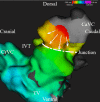Detection of the origin of atrial tachycardia by 3D electro-anatomical mapping and treatment by radiofrequency catheter ablation in horses
- PMID: 35686355
- PMCID: PMC9308432
- DOI: 10.1111/jvim.16473
Detection of the origin of atrial tachycardia by 3D electro-anatomical mapping and treatment by radiofrequency catheter ablation in horses
Abstract
Background: Atrial tachycardia (AT) can be treated by medical or electrical cardioversion but the recurrence rate is high. Three-dimensional electro-anatomical mapping, recently described in horses, might be used to map AT to identify a focal source or reentry mechanism and to guide treatment by radiofrequency ablation.
Objectives: To describe the feasibility of 3D electro-anatomical mapping and radiofrequency catheter ablation to characterize and treat sustained AT in horses.
Animals: Nine horses with sustained AT.
Methods: Records from horses with sustained AT referred for radiofrequency ablation at Ghent University were reviewed.
Results: The AT was drug resistant in 4 out of 9 horses. In 8 out of 9 horses, AT originated from a localized macro-reentrant circuit (n = 5) or a focal source (n = 3) located at the transition between the right atrium and the caudal vena cava. In these 8 horses, local radiofrequency catheter ablation resulted in the termination of AT. At follow-up, 6 out of 8 horses remained free of recurrence.
Conclusions and clinical importance: Differentiation between focal and macro-reentrant AT in horses is possible using 3D electro-anatomical mapping. In this study, the source of right atrial AT in horses was safely treated by radiofrequency catheter ablation.
Keywords: arrhythmia; atrial flutter; electrophysiology; focal atrial tachycardia; supraventricular tachyarrhythmia.
© 2022 The Authors. Journal of Veterinary Internal Medicine published by Wiley Periodicals LLC on behalf of American College of Veterinary Internal Medicine.
Conflict of interest statement
Authors declare no conflict of interest.
Figures



Similar articles
-
Caudal vena cava isolation using ablation index-guided radiofrequency catheter ablation (CARTO™ 3) to treat sustained atrial tachycardia in horses.J Vet Intern Med. 2025 Jan-Feb;39(1):e17251. doi: 10.1111/jvim.17251. Epub 2024 Nov 30. J Vet Intern Med. 2025. PMID: 39614765 Free PMC article.
-
Lesion size index-guided radiofrequency catheter ablation using an impedance-based three-dimensional mapping system to treat sustained atrial tachycardia in a horse.Equine Vet J. 2025 Jul;57(4):1009-1016. doi: 10.1111/evj.14424. Epub 2024 Oct 21. Equine Vet J. 2025. PMID: 39434506
-
Sustained atrial tachycardia in horses and treatment by transvenous electrical cardioversion.Equine Vet J. 2019 Sep;51(5):634-640. doi: 10.1111/evj.13073. Epub 2019 Feb 13. Equine Vet J. 2019. PMID: 30648752
-
Catheter-based electrical interventions to study, diagnose and treat arrhythmias in horses: From refractory period to electro-anatomical mapping.Vet J. 2020 Sep;263:105519. doi: 10.1016/j.tvjl.2020.105519. Epub 2020 Jul 24. Vet J. 2020. PMID: 32928488 Review.
-
Role of radiofrequency ablation in the management of supraventricular arrhythmias: experience in 760 consecutive patients.J Cardiovasc Electrophysiol. 1993 Aug;4(4):371-89. doi: 10.1111/j.1540-8167.1993.tb01277.x. J Cardiovasc Electrophysiol. 1993. PMID: 8269306 Review.
Cited by
-
Feasibility of transthoracic echocardiographic guidance for multicatheter electrophysiological mapping studies in horses.J Vet Intern Med. 2024 Sep-Oct;38(5):2686-2697. doi: 10.1111/jvim.17156. Epub 2024 Aug 3. J Vet Intern Med. 2024. PMID: 39096119 Free PMC article.
-
Orthodromic Atrioventricular Reentry Bradycardia and Tachycardia Caused by an Accessory Pathway in Horses.J Vet Intern Med. 2025 Jul-Aug;39(4):e70175. doi: 10.1111/jvim.70175. J Vet Intern Med. 2025. PMID: 40671630 Free PMC article.
-
Morphological variations of the interatrial septum and potential implications in equine cardiology.Sci Rep. 2025 May 12;15(1):16500. doi: 10.1038/s41598-025-01387-3. Sci Rep. 2025. PMID: 40355652 Free PMC article.
-
Three-dimensional electro-anatomical mapping and radiofrequency ablation as a novel treatment for atrioventricular accessory pathway in a horse: A case report.J Vet Intern Med. 2023 Mar;37(2):728-734. doi: 10.1111/jvim.16668. Epub 2023 Mar 3. J Vet Intern Med. 2023. PMID: 36866668 Free PMC article.
-
In vitro characterization of radiofrequency ablation lesions in equine and swine myocardial tissue.Sci Rep. 2024 Oct 2;14(1):22877. doi: 10.1038/s41598-024-74486-2. Sci Rep. 2024. PMID: 39358479 Free PMC article.
References
-
- van Loon G. Cardiac arrhythmias in horses. Vet Clin N Am Equine Pract. 2019;35(1):85‐102. - PubMed
-
- van Steenkiste G, de Clercq D, Vera L, Decloedt A, van Loon G. Sustained atrial tachycardia in horses and treatment by transvenous electrical cardioversion. Equine Vet J. 2019;51:634‐640. - PubMed
-
- Whelchel DD, Tennent‐Brown BS, Coleman AE, et al. Treatment of supraventricular tachycardia in a horse. J Vet Emerg Crit Care. 2017;27(3):362‐368. - PubMed
-
- van Loon G, Jordaens L, Muylle E, Nollet G, Sustronck B. Intracardiac overdrive pacing as a treatment of atrial flutter in a horse. Vet Rec. 1998;142:301‐303. - PubMed
-
- Saoudi N, Cosio F, Waldo A, et al. Classification of atrial flutter and regular atrial tachycardia according to electrophysiologic mechanism and anatomic bases: a statement from a Joint Expert Group from the Working Group of Arrhythmias of the European Society of Cardiology and the North American Society of Pacing and Electrophysiology. J Cardiovasc Electrophysiol. 2001;22(14):1162‐1182. - PubMed
MeSH terms
Grants and funding
LinkOut - more resources
Full Text Sources

